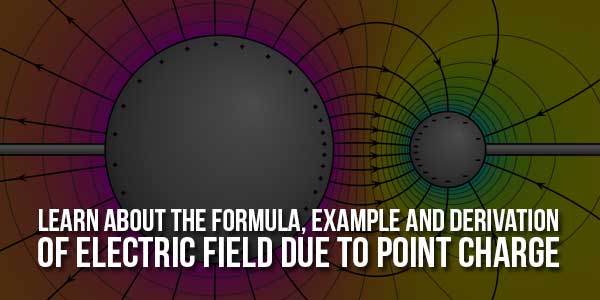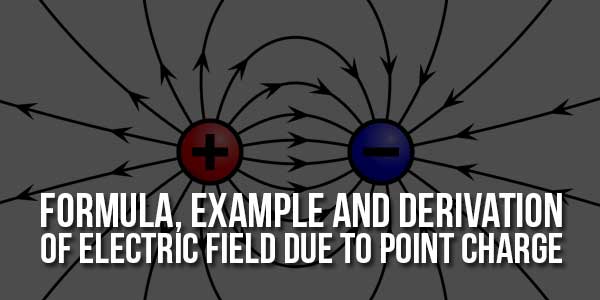
What is Electric Field Due to Point Charges? The electric field is described theoretically as a vector field that relates the electrostatic force per unit of charge exerted on a unit positive test charge at rest at each location in space.
Electric charges and charge arrangements such as capacitors, as well as variable magnetic fields, produce them.
“Every charge in the universe exerts a force on every other charge in the universe” is a physics statement that is both bold and truthful. Imagine the impact of the charge as a field to appreciate its potential to better influence other charges everywhere in space. It’s important to note that this ‘impact’ is merely the electrostatic force that a charge may apply to another charge.
However, when characterising fields, we need a quantity (scalar or vector) that is unaffected by the charge it is operating on and is only affected by the impact and geographical distribution.
We may straightforwardly define the electrostatic field by examining the force produced by a point charge on a unit charge. In other terms, the electric field may be defined as the force per unit charge.
We can introduce a test charge q0 and measure its force to identify an electric field of a charge q.
→FF→ = 14 π ε0qq0r2^r
As a result, per unit of charge, the force exerted is:
→EE→ = →Fq0F→q0 = 14 π ε0qr2^r
It’s worth noting that the electric field is a vector quantity that exists at every point in space and whose magnitude is solely determined by the radial distance from q.
The test charge q0 is capable of producing an electric field around it. As a result, we should make the test charge as modest as possible to avoid its impact.
Thus,
→EE→ =limq0→0→Fq0limq0→0F→q0 = limq0→014 π ε0qq0r2^r×1q0limq0→014 π ε0qq0r2r^×1q0 = 14 π ε0qr2^r
This is a point charge’s electric field. Also, the electric field has the same magnitude on every point of an imaginary sphere centred around the charge q, exhibiting spherical symmetry.
Table of Contents
Electric Field Due To A Point Charge Formula:
Faraday was the first to establish the notion of the field.
The strength of the electric field at any place is the electric field intensity at that point.
It is defined as the force that a positive unit charge feels when placed at a certain spot.
If a force acts on this unit positive charge +q₀ at a location r, the strength of the electric field is given by:
E→(r→)=F→(r→)E→(r→)=F→(r→)
As a result, E is a vector quantity in the direction of the force and parallel to the movement of the test charge +q.
Its metric system is N/C.
The electric field for +q₀ is radially directed outwards from the charge, whereas for – q₀ is radially directed inwards.
Example Of An Electric Field Due To A Point Charge
Assume we need to compute the intensity or strength of the electric field at any point P owing to a point charge Q at O.
OP = r in this case.
Consider the case of a tiny positive charge q₀ at P.
Coulomb’s law states that the interaction force between the charges q₀ and Q at P is,
F=14πϵ0Qq0r2(r) Where r denotes a unit vector pointing from Q to q₀. We're aware, E→(r→)=F→(r→)E→(r→)=F→(r→) /q₀ Therefore, E→=14πϵ0Qr2(r)
Electric Field Derivation As A Result Of A Point Charge:
Assume that the point charge +Q is at A and that OA = r1.
To find the electric field intensity (E) at B, use the formula OB = r2.
Coulomb’s law states that the force on a tiny test charge q2 at B is,
F=14πϵ0q1q2(r12)r212F=14πϵ0q1q2(r12)r122 = 1/4πε₀ q₁q₂ (r₁₂➙)/r₁₂³ F→=14πϵ0q1q2|r2→−r1→|3.(r2→−r1→)F→=14πϵ0q1q2|r2→−r1→|3.(r2→−r1→) Where, AB=r12−→=r2→−r1→AB=r12→=r2→−r1→ As E→=F→q2E→=F→q2 Therefore, F→=14πϵ0q1|r2→−r1→|3.(r2→−r1→)F→=14πϵ0q1|r2→−r1→|3.(r2→−r1→)
As a result, E is created along with AB.

A System Of Point Charges Creates An Electric Field
The vector sum of electric field intensities owing to individual charges at the same place equals the electric field intensity due to a system or group of charges at any point.
The vector sum of electric field intensities would be done now:
E→=E1−→+E2−→+E3−→+...+En−→E→=E1→+E2→+E3→+...+En→ E→=14πϵ0∑i=1i=nQiˆr2i.(ri)
The distance between the point P and the ith charge Qi is given by ri, and ri is a unit vector going from Qi to the point P.
Assume that charges Q1,Q2,….rn are put in vacuum at r1,r2,…..rn, respectively.
The vector total of forces attributable to separate charges, given by, is the net forces at P.
F→=14πϵ0q0∑i=1i=nQi|r→−ri→|3.|r→−ri→|F→=14πϵ0q0∑i=1i=nQi|r→−ri→|3.|r→−ri→| As E→=F→q0 Therefore, F→=14πϵ0q0∑i=1i=nQi|r→−ri→|3.|r→−ri→|F→=14πϵ0q0∑i=1i=nQi|r→−ri→|3.|r→−ri→| Putting 1/4πε₀ = k E→=kQ1/r21+kQ2/r22+...+kQn/r2n
As a result, we derived a formula for the electric field caused by a system of point charges.
A Few Important Points To Remember Which Understanding Electric Field Due To Point Charges:
- The electrostatic force field that surrounds a charged item stretches outward in all directions.
- The electrostatic force produced by a point charge on a test charge at a distance r is proportional to the charge of both charges and the distance between them.
- E=F / q denotes the electric field, with F denoting the Coulomb or electrostatic force exerted on a tiny positive test charge q. The letter E is made up of N/C units.
- E=k|Q|r *r, where r is the distance from Q, is the magnitude of the electric field E generated by a point charge Q. Fields owing to many charges accumulate like vectors, and the electric field E is a vector.
Conclusion:
Contact forces like the one between a bat and all can be explained on a small scale by describing the interaction of the charges in atoms and molecules within proximity. These atoms and molecules interact through forces that include the Coulomb force.
Action at a distance is the force between objects that are not close enough to each other for their atoms to touch. More than a few atomic diameters separate them. For example, a charged rubber comb will attract tiny neutral bits of paper from a distance via the Coulomb Force.
It will always be helpful to imagine an object being surrounded in space by a field of force. This field will carry the force to another object, normally called the test object, at a distance.

















Be the first to write a comment.